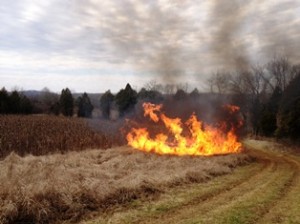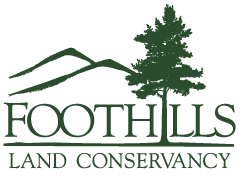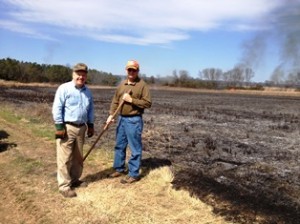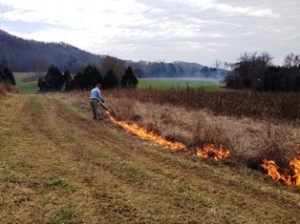Control Burning of Native Warm Season Grasses – Why, When, Where, What and How?

*Please note – this article is not to be utilized as a resource or guide for planning your own control burn but simply for educational purposes only. Any control burn must go through the proper safety measures, permits and notifications specified under local, state and federal laws and regulations.
Most of us, when we see a field engulfed in flames tend to tense up, hope things don’t get out of hand, and are glad it is not our project to tend to! For one man in East Tennessee, the responsibility is often found on his shoulders. When you need a control burn expert for warm season native grasses, the person to call is retired TWRA wildlife habitat biologist and FLC Board Member, Dick Conley.
For 39 years Dick Conley worked for the Tennessee Wildlife Resources Agency. Retired in 2007, Mr. Conley currently provides services as a biologist/forest consultant for several land owners in East Tennessee. He specializes in restoring native warm season grasses and soil building legumes.
In March of 2013, Dick Conley provided a control burn within several sections native warm season grasses within Gene Hartman’s farm. Back in 2008 Mr. Hartman and his wife Becky, partnered with FLC on a conservation easement covering 920 acres on their farm in Roane County. Also there to learn more about these type of control burns was Ken Goddard, Extension Biofuels Specialist with the University of Tennessee.
According to Conley, the most important question to ask before you begin a control burn is, What is your overall objective for your farm? And in this case it is for us to promote quail management. And as a result of that, you are also managing for a multitude of different species like song birds, deer, and turkey. Once the bird’s nesting period is over, burns are then planned. One of the strategies that Conley applies is a checkerboard pattern of burning to allow for standing wildlife cover. For quail and song bird management you don’t want to burn everything. The next year, fields that were not burned the previous year will be evaluated for burning.
As Conley explains, Fields become too dense and wildlife habitat can’t thrive, populations decline. When these dense fields are not controlled, food for the birds like beggar lice, ragweed, and lespedeza can’t be sustained. The general rule of thumb for production fields of warm season grasses utilized for hay and biofuels is one clump per one square foot. For wildlife habitat you want one clump of grass per six square feet, allowing the necessary room for habitat to move around while still being covered.
So what are the optimal weather conditions for burning Conley says there are several major components of a controlled burn – wind velocity should not exceed 4-5 miles , humidity levels should be really no higher than 40-50% and temperatures are close to 40 degrees, and lastly the amount of fuel that is being burned. You want lots of fuel on the ground so it will burn hot. The time of year for a control burn like this is generally from February 15th through the end of March/1st of April.
Once all of these conditions are met, how does Conley approach the actual burn He places a fire line around the perimeter of the field, letting it burn towards the center. He makes sure that there are open spaces around the field so that if the fire moves towards an adjacent area, the site easily be handled utilizing tools and a water tank.
What can be another benefit to a control burn It can make the removal of invasive exotics very easy! In this case, Conley was able to take out a hedgerow of privet quickly. Any invasive shrubs still left standing can be sprayed and removed easily. A short while after the burn, a soil test will be conducted and sent in to the University of Tennessee Agriculture Extension Office. Whatever nutrients the report indicates is lacking within the soil can be added in. For perennial grasses, like switchgrass and gammagrass, the fields will come back post-burn and without any supplemental planting.
A note about the UT Biofuels Initiative
The biofuels contract program for farmers has expired. The program benefitted farmers that grew switchgrass, so that it could ultimately be ground up and converted into ethanol. Folks at the Hartman farm are moving towards keeping most, if not all, of the grass fields for its wildlife cover instead of harvesting a portion of the hay for livestock.
According to Goddard, farmers are looking into the use of native grasses and examining the optimal time to plant and cut for hay, ensuring the maximum nutrition for the cows. Right now, UT is looking into funding research through competitive grants to grow these grasses. Planting native warm season grasses could ultimately help fill in the grazing gap for cool season grasses, like fescue and orchard grass, which are heavily utilized in the livestock business. Goddard mentions that, in the summer farmers typically have to use hay or plant some annual warm season grasses such as sudan grass. It’s nice to have a perennial, like switchgrass, so they don’t have to plant every year. In this way, Goddard sees the planting of switchgrass as having a major benefit while the demand for biofuels kicks back up. He adds, the marketplace for biofuels will move forward by creating both the crop and the demand and so until the biofuel market becomes viable/ commercialized, finding varied, useful ways to incorporate switchgrass makes sense. For additional information about native warm season grasses, please visit The Center for Native Grassland Management.


